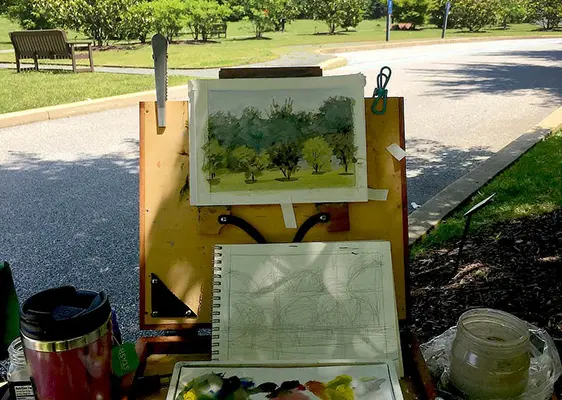Drawing & Painting
Plein Air Painting in Gouache

Enjoy the fun of painting “en plein air” — painting directly from nature on location using gouache (opaque watercolor). Gouache is a fun and easy to use water based medium that dries quickly to a beautiful mat finish. Unlike transparent watercolor, gouache allows for painting light colors over dark, providing greater freedom in how a painting is created and making it more forgiving than transparent watercolor.
Topics will include: finding a landscape subject and creating a composition; starting a painting; understanding value and edges; creating textures to suggest foliage, tree trunks, grasses and other surfaces; gouache paint handling; layering and adjusting the thickness of the paint; brush handling; paint mixing; understanding the color characteristics of hue, value and chroma; and mixing a wide range of colors from a simple limited palette. The class will include demonstration by the instructor as well as individual instruction at each student’s level of experience.
Supply List
- gouache paint in the following 5 colors: Ultramarine Blue, Cadmium Yellow Light (or Pale), Perelyne Maroon (or Alizarin Crimson), Burnt Sienna, Permanent White (Titanium White); (recommended brands: Winsor and Newton Designers Gouache, Holbein, M. Graham, Daniel Smith) (preferably NOT “jelly gouache” or “Himi Gouache” unless you already have some)
- short handled synthetic brushes suitable for acrylic or mixed media (those listed as made from “Golden Taklon” are good): 1/2 flat (ideally 2 of these), 1/4” flat (two of these), 1/8” flat, #2 round;
- watercolor paper 9x12” or 8x10", ideally hot press, cold press also OK, at least 140lb/300gsm or heavier; or watercolor sketchbook with similar paper
- water jar for cleaning brushes (plastic peanut butter jar, for example);
- small water jar for clean water;
- spray mister (atomizer) for keeping paint wet on the palette;
- watercolor or acrylic palette with generous mixing area (a small Masterson “Sta-wet Palette” can be advantageous);
- a few paper towels;
- something to hold your palette and paper like a pochade box, field easel, or drawing board leaned against an extra folding chair; you can also work in your lap in a watercolor sketchbook if you prefer, and use a small folding table for your materials
- plus whatever you need for 3 hours outdoors — folding chair, sunscreen, drinking water, hat, etc. (we will be in the shade)
